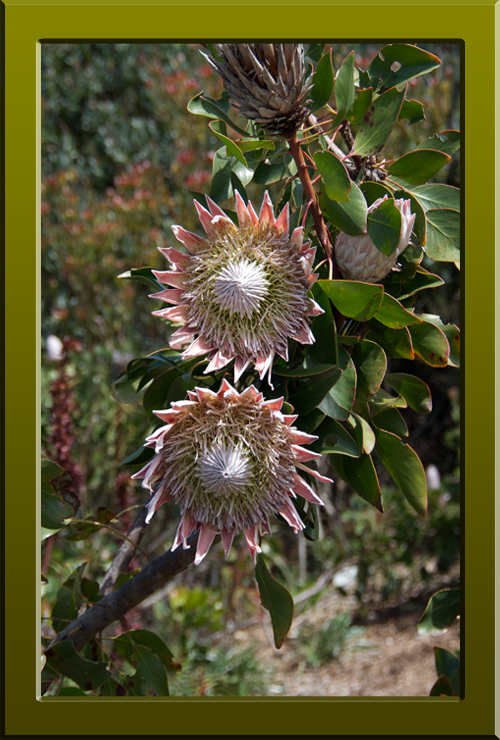Cape BioProvince
Also known as Capensis, this BioProvince (as defined by Armen Takhtajan and others) includes the southern tip of Africa. Its coastal boundary extends from Port Elizabeth in the east to the mouth of the River Olifant in the northwest. On the landward side the boundary extends from the north western town of Nieuwoudtuille following the eastern slopes of the Cedarberg in a southerly direction and then east from Karoopoort along the northern slopes of the Witteburg, Swartberg, Braviaans, Kloff and Groot Winterhoek mountains ending at Port Elizabeth. Its geology roughly coincides with the Cape Supergroup, a Devonian-Ordovician series of sedimentary strata, consisting of alternating layers of quartzitic sandstones and fine-grained shales. These sediments accumulated in basin depository underlain by billion-year-old meta-sediments. Faulting associated with the break up of Gondwanaland exposed this ancient floor, notably on the West Coast forelands where shales predominate. Over a period of some 50 million years, the Cape sediments were violently folded. Since then, the region has remained relatively stable geologically. During this time, the once extraordinarily high landforms have been eroded, shaping todays mountains of resistant quartzitic sandstone, and depositing another sequence of sediments in the fault basins, especially during the Cretaceous. The softer shales in the Cape Supergroup and remnant Cretaceous sediments now form the gentle valleys and undulating plains adjacent to the steep-sided mountains. Deposits of Tertiary limestones, Pleistocene sands and Holocene dunes mantle the coastal margin.
This relatively small area with a Mediterranean type climate has one of the richest concentrations of plants on Earth with some 8550 species, and an astonishing level of endemism. Altogether about 70% or 6252 of species are endemic, and include some 200 endemic genera and 5 endemic families (Bruniaceae, Geissolomataceae, Grubbiaceae, Lanariaceae and Roridulaceae). The main plant formation, actually confined to Capensis, is known as fynbos (fine bush). It is characterised by a complete lack of single species dominance and is generally described as having three main elements: ericoids (sub-shrubs), proteoids (taller bushes) and restioids (tufted rush-like plants). These comprise plants that are either members of the families Ericaceae, Proteaceae or Restionaceae, or have growth forms that are characteristic of these families. The Restionaceae are a group of small rush like herbs that fill the niche usually occupied by grasses, and in fact, grasses are comparatively rare. In terms of species composition fynbos can be broadly divided into Mountain Fynbos, Arid Fynbos, Wet Fynbos and Coastal Fynbos. Other important vegetation types include Strandveld (a coast dune scrub) and Coastal Renosterveld (a zone of scrub dominated by the near endemic Elytropappus rhinocerotis), and remnant forests.
The following accounts for this BioProvince have been written or will be written with particular reference to endemic and locally important species. Accounts available are displayed in green or yellow. Those displayed in red are either in the pipeline or awaiting expert contributions.
| Index |
|---|
| Major Ecosystems |
| Endemic Plants South Africa |
| Bryophyte Flora |
| Fungus Flora |
| Lichen Flora |
| Invertebrate Fauna |
| Amphibian Fauna |
| Reptile Fauna |
| Bird Fauna |
| Mammal Fauna |
| Conservation Status |

Protea cynaroides (Proteaceae) the king protea endemic to the Cape BioKingdom (Copyright © 2010 Peter Martin Rhind).


